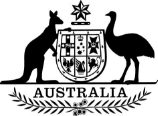
I, Andrew Barr, Chief Minister for the Australian Capital Territory, make the following declaration.
Dated 30 June 2022
Andrew Barr
Chief Minister

I, Andrew Barr, Chief Minister for the Australian Capital Territory, make the following declaration.
Dated 30 June 2022
Andrew Barr
Chief Minister
1 Name
2 Commencement
3 Authority
4 Simplified outline of this instrument
5 Definitions
6 Exemption
7 Significant risk statement
8 Human Rights Act statement
This instrument is the Automatic Mutual Recognition (Australian Capital Territory) (Exemptions—Dangerous Substances) Declaration 2022.
(1) Each provision of this instrument specified in column 1 of the table commences, or is taken to have commenced, in accordance with column 2 of the table. Any other statement in column 2 has effect according to its terms.
Commencement information | ||
Column 1 | Column 2 | Column 3 |
Provisions | Commencement | Date/Details |
1. The whole of this instrument | 1 July 2022. | 1 July 2022. |
Note: This table relates only to the provisions of this instrument as originally made. It will not be amended to deal with any later amendments of this instrument.
(2) Any information in column 3 of the table is not part of this instrument. Information may be inserted in this column, or information in it may be edited, in any published version of this instrument.
This instrument is made under section 42S of the Mutual Recognition Act 1992 of the Commonwealth.
4 Simplified outline of this instrument
The purpose of this instrument is to exempt registrations for dangerous substances occupations, or for activities covered by dangerous substances occupations, from the automatic deemed registration provisions of the Mutual Recognition Act 1992 of the Commonwealth until 1 July 2025 because of a significant risk to the health and safety of workers or the public.
This instrument has effect only in relation to the Australian Capital Territory.
In this instrument:
Act means the Mutual Recognition Act 1992 of the Commonwealth.
For section 42S(1)(a) of the Act, a registration under the Dangerous Substances (Explosives) Regulation 2004 and the Dangerous Substances (General) Regulation 2004 of the Australian Capital Territory is excluded from the operation of automatic deemed registration in the Australian Capital Territory until 1 July 2025 because of the significant risks set out in section 7.
For section 42S(2) of the Act, the exclusion in section 6 is necessary because of the significant risk in the ACT to the health and safety of workers or the public. Dangerous substances, especially asbestos, are a risk to the community, and in particular, the health and safety of workers. Notwithstanding the provisions under the AMR scheme relating to notification of intention to work and information sharing powers and obligations, there could be a diminution in regulatory oversight under AMR of individuals operating in the ACT from time to time. This is because once a supplier notifies of an intention to work, no further notification is required. This may diminish the ongoing regulatory relationship between ACT’s regulator WorkSafe ACT and individuals working with dangerous substances until risk mitigation strategies can be implemented as the ACT is a jurisdiction with a high proportion of interstate workers. A reliable and robust, nationally consistent approach to dangerous substances legislation will ensure that the regulator, WorkSafe ACT, can properly exercise its obligations and powers under AMR. This will be progressed during the exemption period.
Section 40B(1) of the Human Rights Act 2004 (ACT) provides that it is unlawful for public authorities to act in a way that is incompatible with a human right or, in making a decision, fail to give proper consideration to a relevant human right. Accordingly, in making this exclusion in section 6, I have considered any relevant human rights that may be impacted as required by s40B. Section 27B(1) of the Human Rights Act 2004 provides that everyone has the right to work, including the right to choose their occupation or profession freely. I am satisfied that the making of the exclusion in section 6 would not be incompatible with the right to work and the right to choose an occupation or profession freely.
While the exclusion may limit the right to work, it is important to note that the making of the exclusion does not prevent an individual from carrying on an activity covered by dangerous substances occupations in the ACT. Rather, the making of the exclusion will mean that all individuals who wish to carry on an activity covered by dangerous substances occupations in the ACT must meet particular registration requirements set out in ACT law. Upon meeting the relevant registration requirements, individuals would be able to carry on an activity covered by dangerous substances occupations in the ACT. The registration requirements are a necessary, proportionate and reasonable measure through which safeguards are provided to protect workers. Any limitation on the right to work is reasonable and justified because the exclusion will allow the ACT to address risks associated with the transitioning to AMR while ensuring there is no diminution in current levels of safeguards in relation to the health and safety of workers or the public.